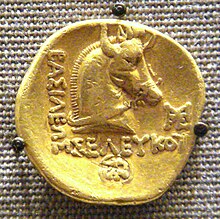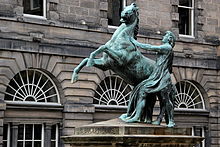 Coin depicting Bucephalas, issued by Seleucus I Nicator. Note the horns on his head, from a literal interpretation of his name, which means "ox-head(ed)". Coin depicting Bucephalas, issued by Seleucus I Nicator. Note the horns on his head, from a literal interpretation of his name, which means "ox-head(ed)". | |
| Species | Horse |
|---|---|
| Sex | Male |
| Born | c. 355 BC |
| Died | June 326 BC (aged 30) Pentapotamia, Macedonian Empire (modern-day Pakistan) |
| Resting place | Bucephala |
| Occupation | Warhorse |
| Years active | 344 BC – 326 BC |
| Owner | Alexander III of Macedon |
Bucephalus (/bjuː.ˈsɛ.fə.ləs/; Ancient Greek: Βουκεφᾰ́λᾱς, romanized: Būcephắlās; c. 355 BC – June 326 BC) or Bucephalas, was the horse of Alexander the Great, and one of the most famous horses of classical antiquity. According to the Alexander Romance (1.15), the name "Bucephalus" literally means "ox-headed" (from βοῦς and κεφᾰλή), and supposedly comes from a brand (or scar) on the thigh of the horse that looked like an ox's head.
Ancient historical accounts state that Bucephalus's breed was that of the "best Thessalian strain", and that he died in what is now Punjab, Pakistan, after the Battle of the Hydaspes in 326 BC. Alexander was so grieved at the loss of his horse that he named one of the many cities he founded after him, as Alexandria Bucephalus.
Taming of Bucephalus

A massive creature with a massive head, Bucephalus is described as having a black coat with a large white star on his brow. He is also supposed to have had a "wall eye" (blue eye), and his breeding was that of the "best Thessalian strain".
Plutarch says that in 344 BC, at twelve or thirteen years of age, Alexander of Macedonia won the horse by making a wager with his father: a horse dealer named Philonicus the Thessalian offered Bucephalus to King Philip II for the remarkably high sum of 13 talents. Because no one could tame the animal, Philip was not interested. However, Alexander was, and he offered to pay himself should he fail.
Alexander was given a chance and surprised all by subduing the horse. He spoke soothingly to the horse and turned its head toward the sun so that it could no longer see its own shadow, which had been the cause of its distress. Dropping his fluttering cloak as well, Alexander successfully tamed the horse. Plutarch says that the incident so impressed Philip that he told the boy, "O my son, look thee out a kingdom equal to and worthy of thyself, for Macedonia is too little for thee." Philip's speech strikes the only false note in the anecdote, according to A. R. Anderson, who noted his words as the embryo of the legend fully developed in the History of Alexander the Great I.15, 17.
The Alexander Romance presents a mythic variant of Bucephalus's origin. In this tale, the colt, whose heroic attributes surpassed even those of Pegasus, is bred and presented to Philip on his own estates. The mythic attributes of the animal are further reinforced in the romance by the Delphic Oracle who tells Philip that the destined king of the world will be the one who rides Bucephalus, a horse with the mark of the ox's head on his haunch.
Alexander and Bucephalus



As one of his chargers, Bucephalus served Alexander in numerous battles.
The value which Alexander placed on Bucephalus emulated his hero and supposed ancestor Achilles, who claimed that his horses were "known to excel all others—for they are immortal. Poseidon gave them to my father Peleus, who in his turn gave them to me."
Arrian states, with Onesicritus as his source, that Bucephalus died at the age of thirty. Other sources, however, give as the cause of death not old age or weariness, but fatal injuries at the Battle of the Hydaspes (June 326 BC), in which Alexander's army defeated King Porus. Alexander promptly founded a city, Bucephala, in honour of his horse. It was on the west bank of the Hydaspes river (modern-day Jhelum in Pakistan). The modern-day town of Jalalpur Sharif, outside Jhelum, is said to be where Bucephalus is buried.
The legend of Bucephalus grew in association with that of Alexander, beginning with the fiction that they were born simultaneously: some of the later versions of the Alexander Romance also synchronized the hour of their death. The Bucephalus appears in almost all versions of the Armenian Alexander Romance, and visual illustrations in the surviving manuscripts of this text sometimes represent scenes with the Bucephalus.
See also
References
- Wasson, Donald (6 October 2011). "The Bucephalus". World History Encyclopedia.
- ^ Kouymjian, Dickran (2012). "Did Byzantine Iconography Influence the Large Cycle of the Life of Alexander the Great in Armenian Manuscripts?". Byzantium and Renaissances. Dialogue of Cultures, Heritage of Antiquity, Tradition and Modernity. University of Warsaw Press. pp. 209–216.
- The primary (actually secondary) accounts are two: Plutarch's Life of Alexander, 6, and Arrian's Anabasis Alexandri V.19.
- ^ Plutarch, Parallel Lives, "Life of Alexander" 6 (ed. Clough 1859; ed. Loeb).
- Anderson 1930:3 and 17ff.
- Homer, The Iliad, Book XXIII.
- Rolf Winkes, "Boukephalas", Miscellanea Mediterranea (Archaeologia Transatlantica XVIII) Providence 2000, pp. 101–107.
- Michael Wood, "In the footsteps of Alexander the Great".
- Andrew Runni Anderson, "Bucephalas and His Legend" The American Journal of Philology 51.1 (1930:1–21).
External links
 Media related to Bucephalus (horse of Alexander) at Wikimedia Commons
Media related to Bucephalus (horse of Alexander) at Wikimedia Commons